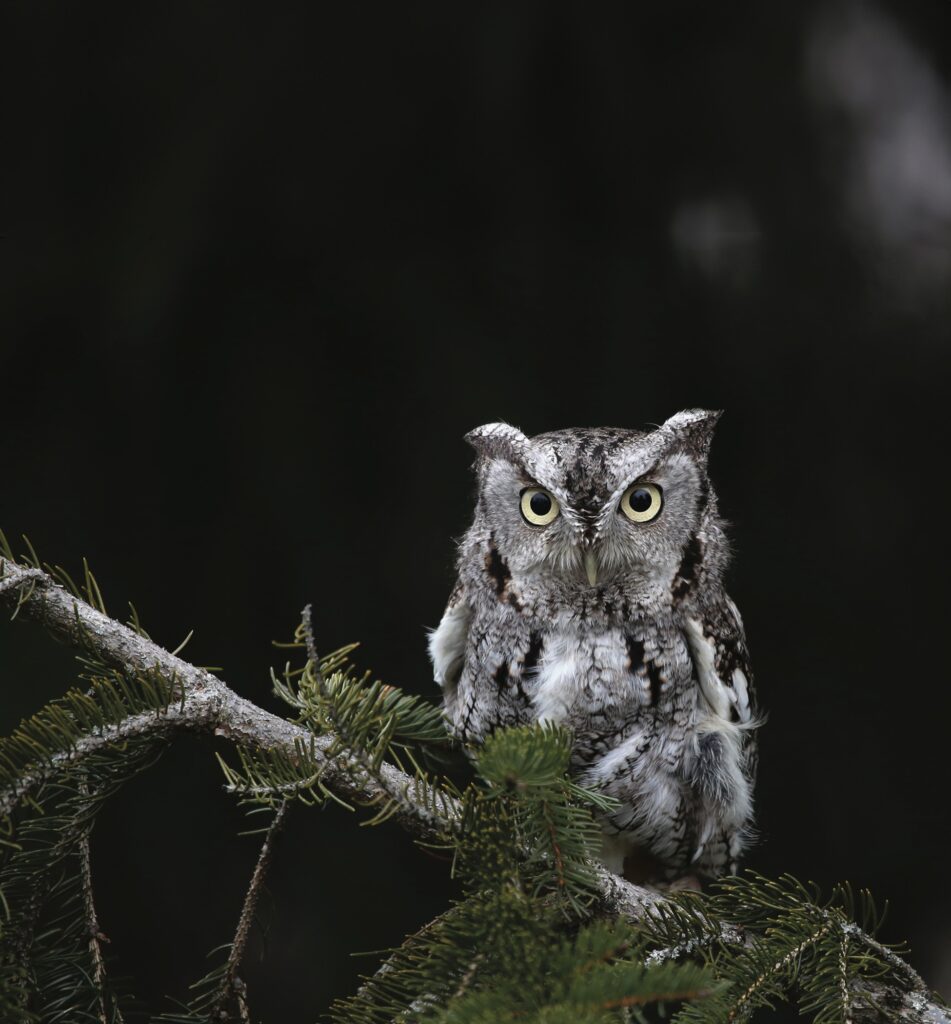BIRDWATCH

They’re a Hoot
Keep a sharp ear out
By Susan Campbell
Listen . . . an eerie trill or spooky shriek from out of the darkness at this time of year just might indicate the presence of an eastern screech-owl. Territorial adults readily use a mix of screams, tremolos with different pitches and long trills to advertise the boundaries of their home range. Their vocalizations are remarkably loud for such small birds: Screech-owls only stand about 8 inches high. They can be found in forests all over North Carolina, especially in thick pine stands, so much of our Piedmont habitat is great for them. Furthermore, they are with us year-round.
Eastern screech-owls can be either a dull gray or a rich rufous color. Dark splotches and vertical striping on the breast and belly provide excellent camouflage against tree bark, where they can be found roosting during daylight hours. Tufts of feathers on the head give an eared or horned appearance. They may be sitting close to a tree trunk or peering out of a cavity. As is the case with most raptors, females are larger than males. Nonetheless, females have higher pitched calls. Rarely are they seen, unless crows or flocks of songbirds signal their presence by frenzied flight and raucous calling.
This species is found throughout the eastern United States as well as along the Canadian border and in easternmost Mexico. Although they may wander somewhat outside of the breeding season, eastern screech-owls are not migratory. These diminutive owls breed in the springtime. Pairs, who usually stay together for life, nest in cavities, utilizing old squirrel or woodpecker holes as well as purple martin houses and wood duck boxes. Not surprisingly, pairs of screech-owls will readily take to boxes made to their exact specifications. A female simply lays up to six white eggs on the substrate at the bottom of the cavity. Incubation takes about a month, and then the young birds take another month to develop before they fledge. During this period, while the female remains on the nest, her mate will hunt nightly for the growing family.
Eastern screech-owls eat a wide variety of prey. Rodents are a large portion of their diet, but they also readily catch frogs, large insects and other invertebrates, including crayfish and even earthworms. They have been known to feed on roosting birds and the occasional bat. Screech-owls are very much at home feeding on mice, rats or voles that can be found around bird feeders at night — as well as moths and beetles attracted to outside lights. These birds adopt a “sit-and-wait” strategy, then pounce on their prey and swallow it whole. Owl gizzards are specially adapted to digest the soft parts of the creatures they eat and then ball up the bones, fur and other indigestible bits into an oval mass that is regurgitated each day. Favored roost sites or nest cavities can be found by locating piles of these masses (or pellets, as they are referred to) on the forest floor. Unfortunately, screech-owls often hunt along roadsides and are prone to being hit by cars as they swoop low over the pavement to grab a meal.
Overall, however, eastern screech-owls are a successful species that has adapted well to the changes humans have made to the landscape. In fact, urban individuals tend to be more successful than their suburban counterparts, likely due to several factors, including fewer predators, more available prey and plenty of cavities in the landscape. So, spend some time outside after dark and train your ears for the trill or tremolos of our eastern screech-owl. No doubt there are one or two living in your neighborhood. These cute little birds are anything but scary once you get to know them.
